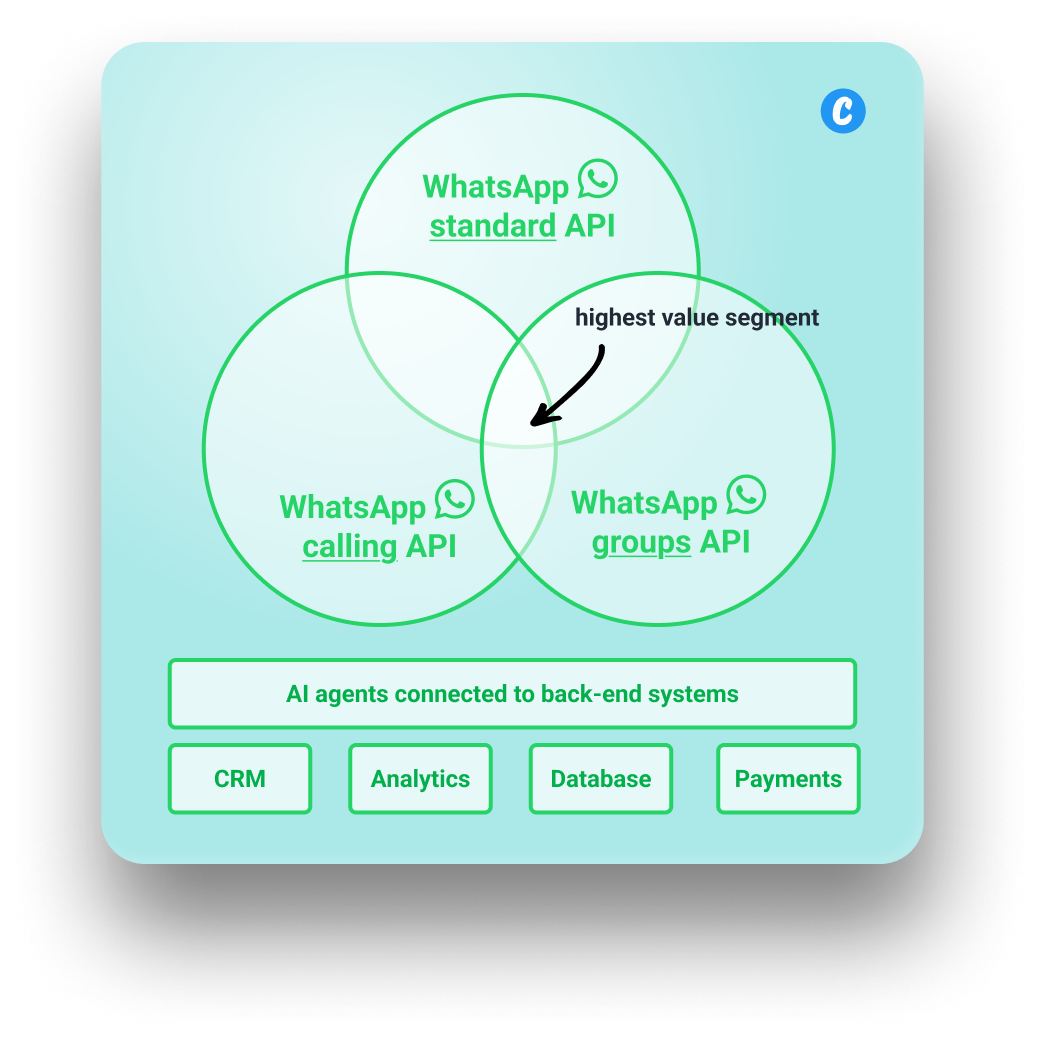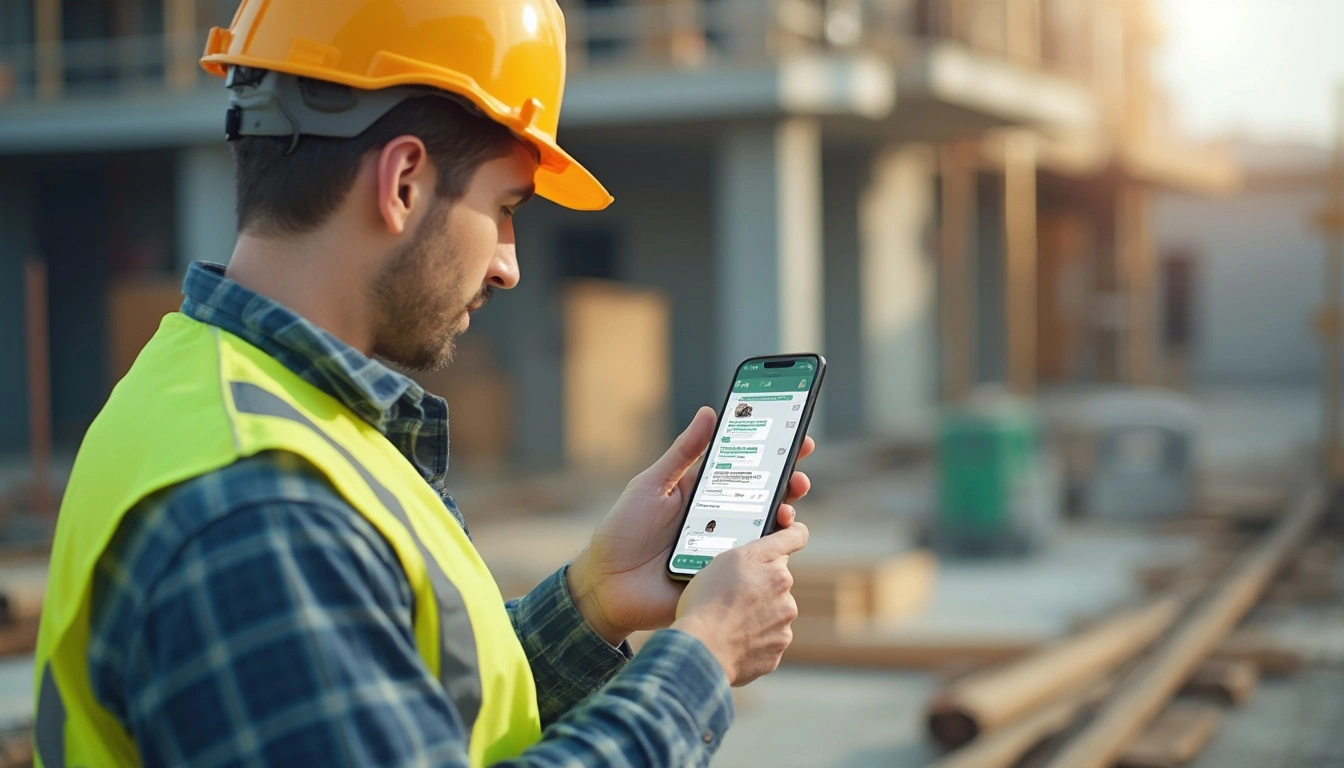WhatsApp Groups API: What We Learned as an Alpha Partner
As an Alpha partner with WhatsApp's new Groups API functionality, we've spent the past year deep in the trenches, and we're sharing what we learned.
.png)
Integrate your CRM with other tools
Lorem ipsum dolor sit amet, consectetur adipiscing elit lobortis arcu enim urna adipiscing praesent velit viverra sit semper lorem eu cursus vel hendrerit elementum morbi curabitur etiam nibh justo, lorem aliquet donec sed sit mi dignissim at ante massa mattis.
- Neque sodales ut etiam sit amet nisl purus non tellus orci ac auctor
- Adipiscing elit ut aliquam purus sit amet viverra suspendisse potenti
- Mauris commodo quis imperdiet massa tincidunt nunc pulvinar
- Adipiscing elit ut aliquam purus sit amet viverra suspendisse potenti
How to connect your integrations to your CRM platform?
Vitae congue eu consequat ac felis placerat vestibulum lectus mauris ultrices cursus sit amet dictum sit amet justo donec enim diam porttitor lacus luctus accumsan tortor posuere praesent tristique magna sit amet purus gravida quis blandit turpis.

Techbit is the next-gen CRM platform designed for modern sales teams
At risus viverra adipiscing at in tellus integer feugiat nisl pretium fusce id velit ut tortor sagittis orci a scelerisque purus semper eget at lectus urna duis convallis. porta nibh venenatis cras sed felis eget neque laoreet suspendisse interdum consectetur libero id faucibus nisl donec pretium vulputate sapien nec sagittis aliquam nunc lobortis mattis aliquam faucibus purus in.
- Neque sodales ut etiam sit amet nisl purus non tellus orci ac auctor
- Adipiscing elit ut aliquam purus sit amet viverra suspendisse potenti venenatis
- Mauris commodo quis imperdiet massa at in tincidunt nunc pulvinar
- Adipiscing elit ut aliquam purus sit amet viverra suspendisse potenti consectetur
Why using the right CRM can make your team close more sales?
Nisi quis eleifend quam adipiscing vitae aliquet bibendum enim facilisis gravida neque. Velit euismod in pellentesque massa placerat volutpat lacus laoreet non curabitur gravida odio aenean sed adipiscing diam donec adipiscing tristique risus. amet est placerat.
“Nisi quis eleifend quam adipiscing vitae aliquet bibendum enim facilisis gravida neque velit euismod in pellentesque massa placerat.”
What other features would you like to see in our product?
Eget lorem dolor sed viverra ipsum nunc aliquet bibendum felis donec et odio pellentesque diam volutpat commodo sed egestas aliquam sem fringilla ut morbi tincidunt augue interdum velit euismod eu tincidunt tortor aliquam nulla facilisi aenean sed adipiscing diam donec adipiscing ut lectus arcu bibendum at varius vel pharetra nibh venenatis cras sed felis eget.
The WhatsApp Groups API just went fully live, see WhatsApp docs listing it as Generally Available. Most developers can now access what we believe is one of the most disruptive messaging APIs ever released.
As an Alpha partner with WhatsApp, we've spent the past year deep in the trenches, integrating this technology and shipping real value for businesses. WhatsApp's technical docs are solid, but they don't answer the questions businesses ask when they're trying to reimagine customer communication. And that’s ok, technical docs rarely answer business questions. So we're sharing what we've learned. Here are the top questions we've fielded since August 2024:
1. What is the WhatsApp Groups API, and what's it actually for?
The WhatsApp Groups API provides medium to large businesses with the ability to include multiple employees and customers in a single group chat. The business is the admin. And because it's built on top of the WhatsApp Business API, you can place AI agents behind your business phone number.
2. What verticals does WhatsApp Groups API offer the most value?
WhatsApp Groups API offers value across all verticals simply because it should be used where your best customers are already chatting with your employees. In other words, it is to be applied to your most valuable customer conversations, regardless of vertical. Obvious verticals include: Private Banking, Luxury Retail, Travel, Hospitality, Automotive, B2B Software & Professional Services.
3. What is an example use case for WhatsApp Groups API?
WhatsApp Groups API is best used for high value relationships across verticals. In the real estate vertical, consider a couple purchasing their first home. With the Groups API, both buyers can communicate with their real estate agent, mortgage broker, lawyer, and an AI-powered concierge, all in one thread with complete business workflow integration.
4. How many participants can join a group?
Eight participants plus the business phone number. Not huge, but that's the point. These aren't broadcast channels. They're micro-groups built for high-value, multi-party relationships.
5. Can we use WhatsApp Groups API for marketing purposes?
Yes, but be strategic. You can run marketing use cases inside groups, and you can send business-initiated templates inside groups. Our recommendation: lean into utility templates wherever possible. Marketing templates get rate-limited faster than one-to-one conversations, and WhatsApp is watching closely.
6. Can we scale groups beyond 8 participants?
No, at least not right now. WhatsApp will never let these groups become spam factories. The architecture is intentional: high-value relationships in micro groups, not loosely connected macro groups. If you're thinking broadcast, you're looking at the wrong API. It is possible WhatsApp could raise the limit from 8 to 20, but Coral doesn't predict groups will be larger for the foreseeable future.
7. Can we just add people to groups?
No, you have to first invite all participants, and they can choose to join the group by clicking a link. This is true opt-in, and is part of the WhatsApp process.
8. Can we customize the group subject and thumbnail?
Yes. You can change both via API for groups. Brand it, personalize it, make it yours.
9. What's WhatsApp's business model for WhatsApp Groups API?
WhatsApp charges for all business-initiated template sends, just as it does in direct chats. Standard stuff. However, here's where it gets interesting: all messages from participants on the WhatsApp consumer app are free. That's a massive cost advantage for businesses running multi-party conversations.
10. Can we add our business number to existing consumer groups?
No. WhatsApp considers this a data privacy risk. You need to create a new group via API and invite employees and customers into it. Clean slate only. This means, as a business, you need to think about when and how to create a new group with new customers, which Coral can help you solution.
11. Does WhatsApp distinguish between employee and customer phone numbers?
WhatsApp doesn't. At Coral, we distinguish between employee and customer phone numbers in our data schema and the AI agents we create on top. It matters for workflows, permissions, and intelligence.
12. How long do groups last?
Indefinitely. WhatsApp built for the long term, and even if the business phone number never sends a message, participants can chat forever.
13. Can I delete a group that I created?
Yes, you can delete a group that you created, this follows the same flow as creating and deleting a group in the WhatsApp Consumer App, but for business you need to do so using APIs
14. Are all phone numbers visible in the group?
Yes. Every phone number is visible to all participants, including the business API phone number. Everyone who's invited needs to opt in to enter.
15. What are the restrictions of the WA Groups API?
While the WA Groups API is a very innovative and disruptive offering, there are some restrictions that should be considered before investing any Product or Engineering time:
i) a max of 8 participants can be invited into a group, which means this is for high-value micro groups, not large spammy groups
ii) a business cannot add its API group phone number into an existing chat, as that's considered a data privacy concern by WhatsApp; if a group already exists, then a new group needs to be created.
iii) if WhatsApp restricts access to you because you are not an Official Business Account (OBO) or have not earned the 100k message limit status, then apply for access with www.coralmessaging.com or another provider (see below).
16. What vendors have access to the WhatsApp Groups API?
Any Meta Tech Partner or BSP with 100k Business Initiated message limit is allowed by WhatsApp to develop on this new API, so that is a long list of BSPs across the world. However, the below list are the only ones who have already developed on the API. Coral is the only vendor who has dedicated their whole roadmap to the WhatsApp Groups API and offers custom solutions, not just the raw API or an API wrapper.
- Coral Messaging
- 360Dialog
- Twilio
- Sanuker/Woztell
- Gupshup
- Global Relay
The list of providers that have made WhatsApp Groups API accessible to any customer is a smaller list:
- Coral Messaging
- 360Dialog
- Sanuker/Woztell
The bottom line: The WhatsApp Groups API isn't just a feature release. It's a fundamental shift in how businesses can orchestrate high-value, multi-party relationships at scale. We've seen it unlock use cases that were impossible twelve months ago. If you want to build on the WhatsApp Groups API, reach out. We've made the mistakes so you don't have to.

.png)

.png)